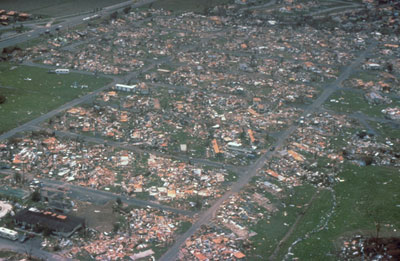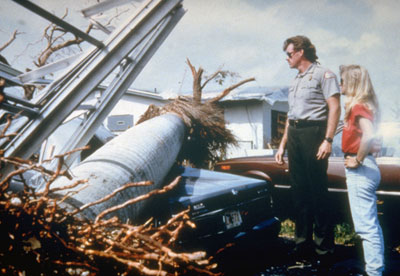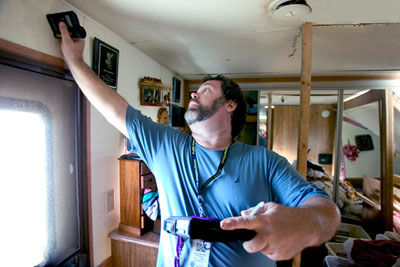
 |
|
Hurricane Andrew left 250,000 homeless and caused $26 billion in damages in south Florida. |
In addition to improved coordination among emergency responders and advancements in weather forecasting technology, the state’s building code regulatory system is regarded as one of the most efficient in the country. In fact, in a recent study of building code systems conducted by the Insurance Institute for Business & Home Safety (IBHS), Florida and Virginia rated the highest of 18 coastal states.
“Florida has been the leader,” said Tim Reinhold, Vice President of Engineering for IBHS. “From a structural standpoint, it’s been a huge win wherever (the Florida Code) is in place.”
In the midst of two building booms that doubled the state’s population between 1960 and 1990, Florida adopted a statewide building code in 1974 that gave most authority to local jurisdictions with some guidance from the state. The population boom and code adoption coincided with a lull in major hurricanes striking Florida, which created a sense of complacency among residents, according to Kate Hale, former director of Miami-Dade Emergency Management. “Most people in our community at that point were still of the mind that we just don't have hurricanes here anymore,” she said. “There really was that perception because we were in one of those lulls.”
That mindset changed, of course, following Hurricane Andrew in August 1992. The late Florida Governor Lawton Chiles formed the Governor’s Building Code Study Commission, which was charged with evaluating the state’s existing system and developing recommendations for reform. The 28-member commission consisted of code officials and other local government representatives, labor unions, state agencies, real estate and banking interests, building contractors and the general public.
 |
|
Following Hurricane Andrew, the late Governor Lawton Chiles formed the Governor's Building Code Study Commission, which was charged with evaluating the state's existing system and developing recommendations for reform. |
Bob Boyer, Codes, Products and Training Coordinator for the Palm Beach County Planning, Zoning and Building Department and a current member of the Code Council Board of Directors, said he and many others got an eyeful when viewing the devastation following Andrew. “We had to do something, or people wouldn’t be able to get insurance down here,” said Boyer, who served on one of the working groups of the commission. “We couldn’t evacuate everyone. It made us realize, we had to strengthen the codes and enforce them.”
“The eyes of the state were on us,” added Mo Madani, Technical Unit Manager for the State of Florida who also served on one of the working groups of the commission. “There was a lot of frustration by the home builders because of variations in the codes. We needed better enforcement and uniformity in the codes.”
After 16 months of meetings, the commission’s recommendations were outlined in five areas:
1. Development and adoption of a single statewide building code;
2. State licensing and regulation of contractors with the exception of some specialty licenses;
3. State level discipline but local enforcement of the code;
4. Formation of the Florida Building Commission, which would oversee adoptions, amendments and most interpretations of the statewide code;
5. A streamlined, cost-effective product evaluation and approval process.
Dominic Sims, Executive Vice President and Director of Operations for the Code Council who previously served as Executive Director of the Palm Beach County Planning, Zoning and Building Department, said the commission’s challenge was daunting but achievable. “The old adage, ‘Those who forget history and the power of nature are sure to repeat it,’ remains a battle cry for code officials who are working every day to protect lives and property,” said Sims, who served as vice chair of the commission. “That sentiment certainly set the tone for our work.”
Initially, the proceedings were known to get pretty heated between stakeholders. “Some of us battled with each other,” Tylka said. “But then we settled down.”
Boyer called it “a true compromise process. We all had things we wanted in there, but we came together for the common safety of the people.”
Tylka said that when the Florida legislature approved the new statewide building code in 1998, others throughout the nation saw the benefits of one set of codes. He believes that helped set in motion the eventual consolidation of the legacy organizations into the International Code Council in 2002.
Boyer also believes the work done toward the Florida Building Code helped paved the way for the ICC consolidation. “People realized we were all in this together, regardless of where we are,” he said. “Code enforcement and inspections are keys to a safer built community.”
Added Sims: “The commission received some critical input from states like New Jersey, North Carolina and Virginia. The final work product impacted not just the Southeast region but the entire country and provided an excellent blueprint for the future of unified code systems.”
 |
|
Studies show that Florida's post-Hurricane Andrew building code stood its ground against later hurricanes, including Hurricane Charley in 2005. |
“In 2005, University of Florida researchers completed one of the most extensive studies of how homes built before and after Florida’s post-Hurricane Andrew building code stood their ground against later hurricanes,” Sims said. “The study’s conclusion: Homes built under the new code that became effective in 2002 sustained less damage on average than those built between 1994 and 2001.’”
One year later, a Florida legislative report’s findings were the same: “During 2005 Florida was besieged by a series of three hurricanes that tested the code once again. Although Hurricanes Dennis, Katrina, and Wilma were devastating to the citizens of the state, they added further evidence that the Florida Building Code is working.”
Madani pointed out that the Florida Building Code has gotten even stronger over the years after updates in 2004, 2007 and 2010, and is on schedule for an update again in 2015. Sims said implementing the latest advancements in science and technology into the ongoing development of codes is fundamental to the future of building safety.
“Florida and the rest of the nation have come a long way in the past two decades,” Sims concluded. “But our work to protect the public will never be done.”